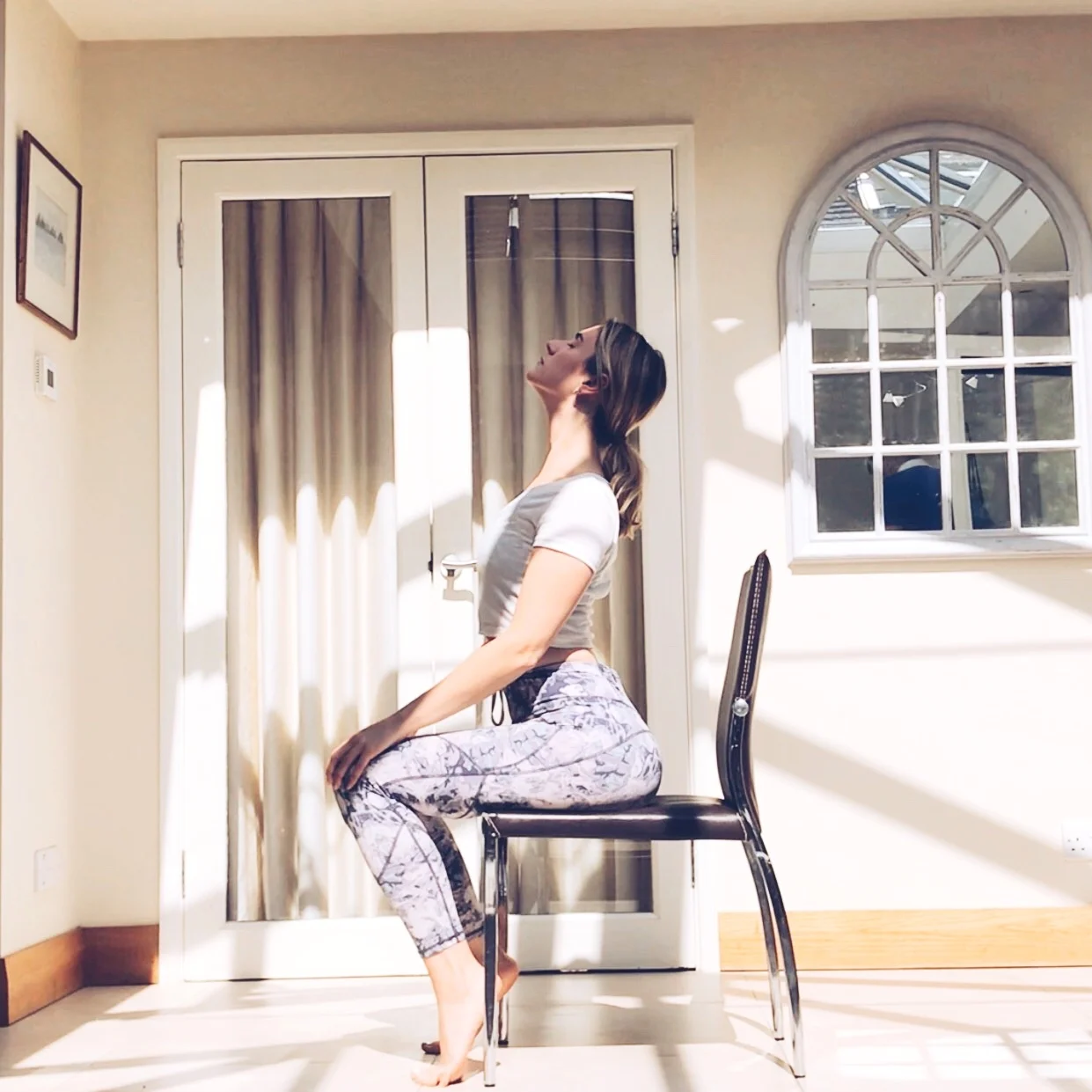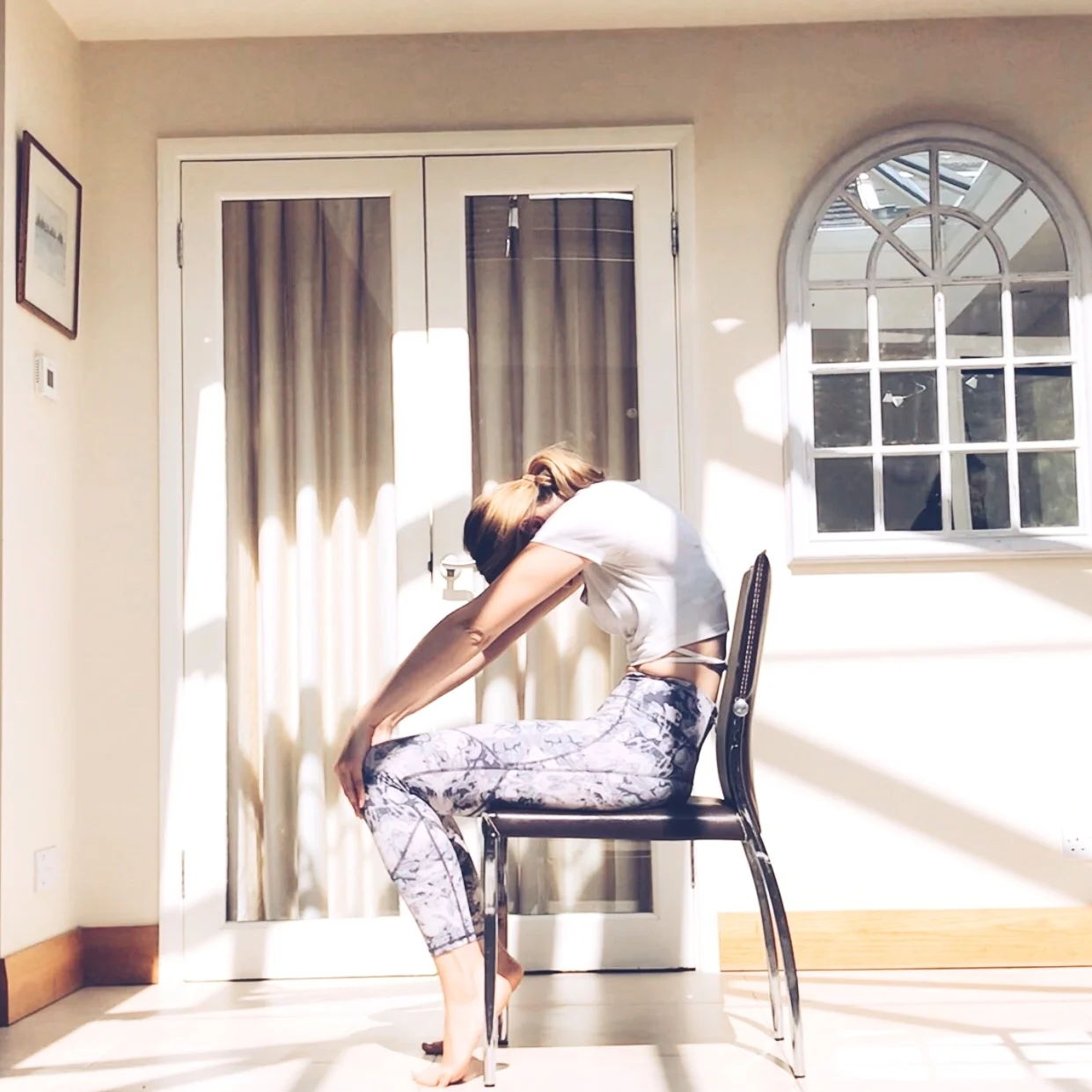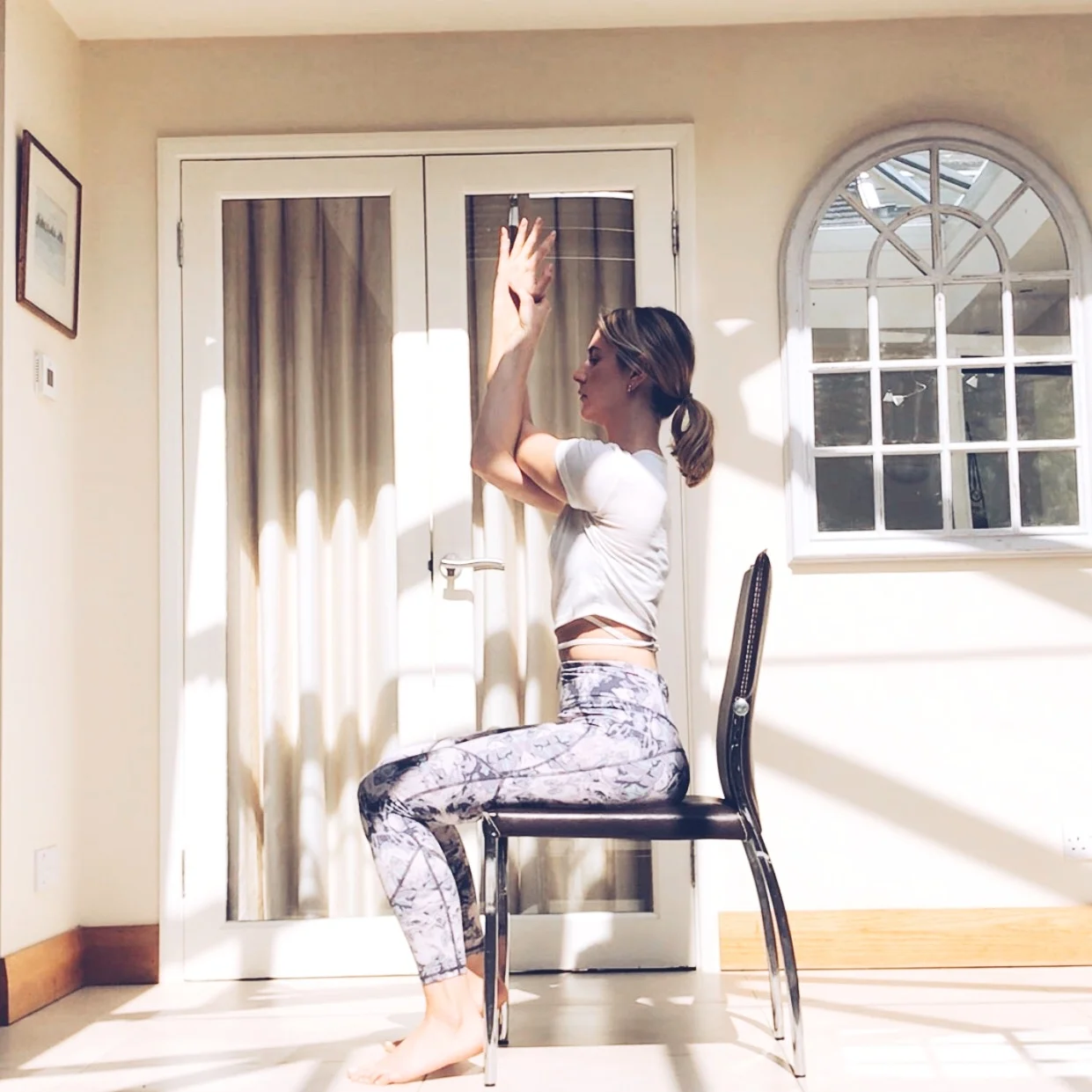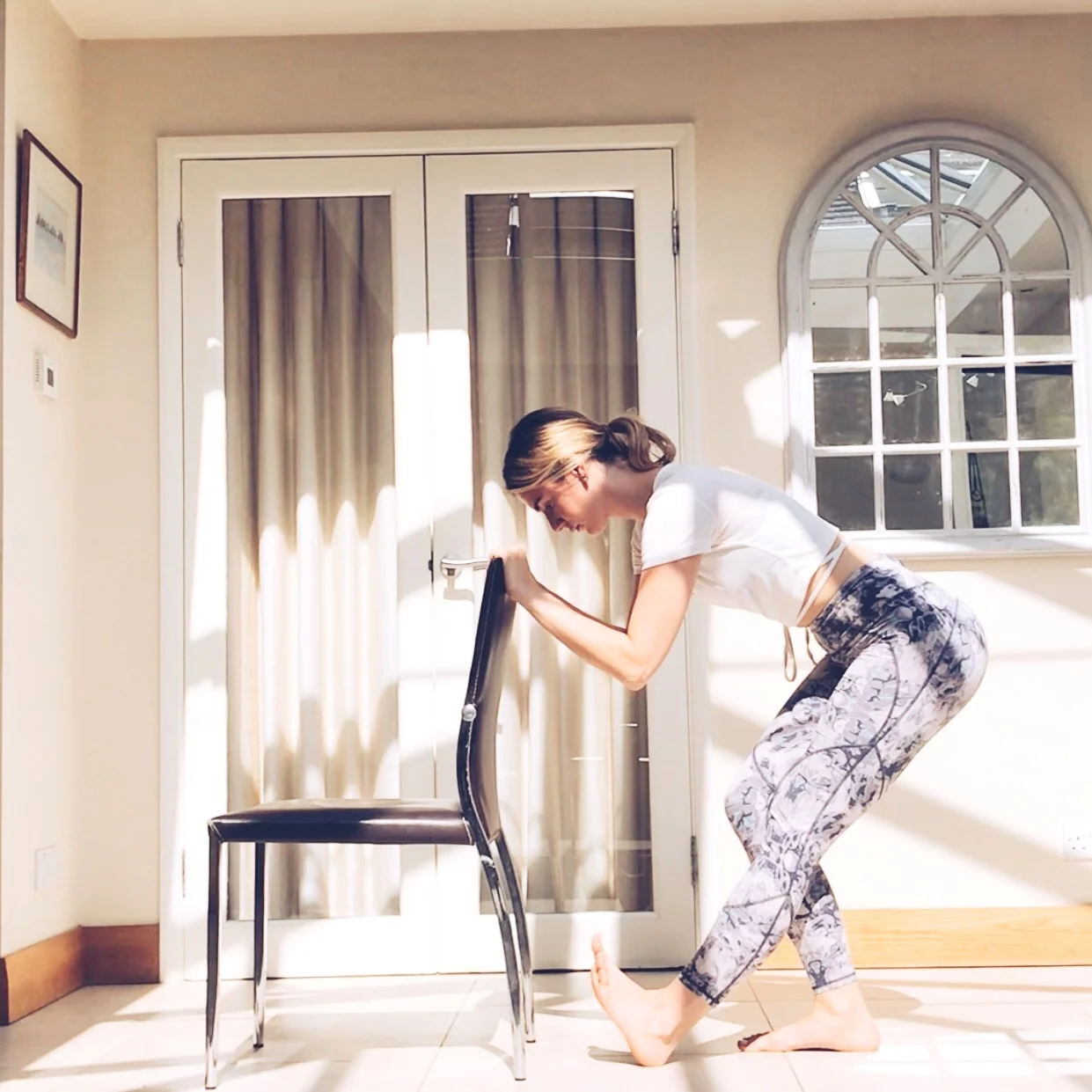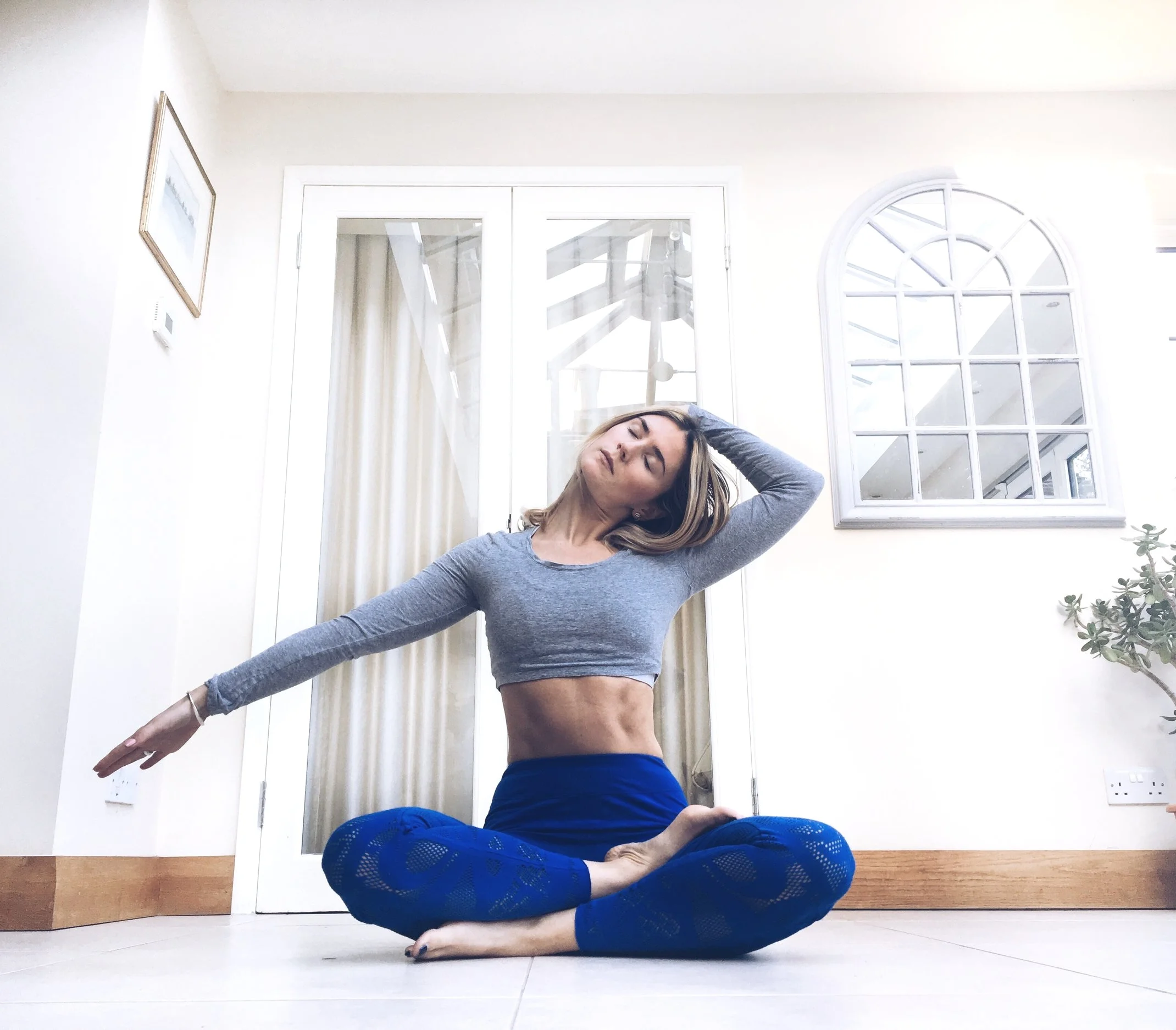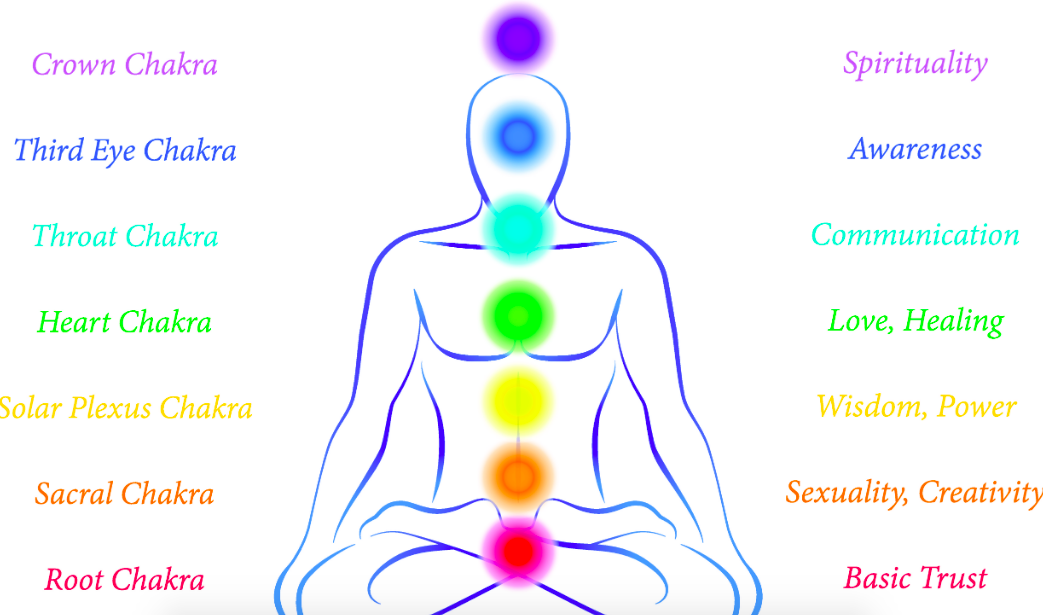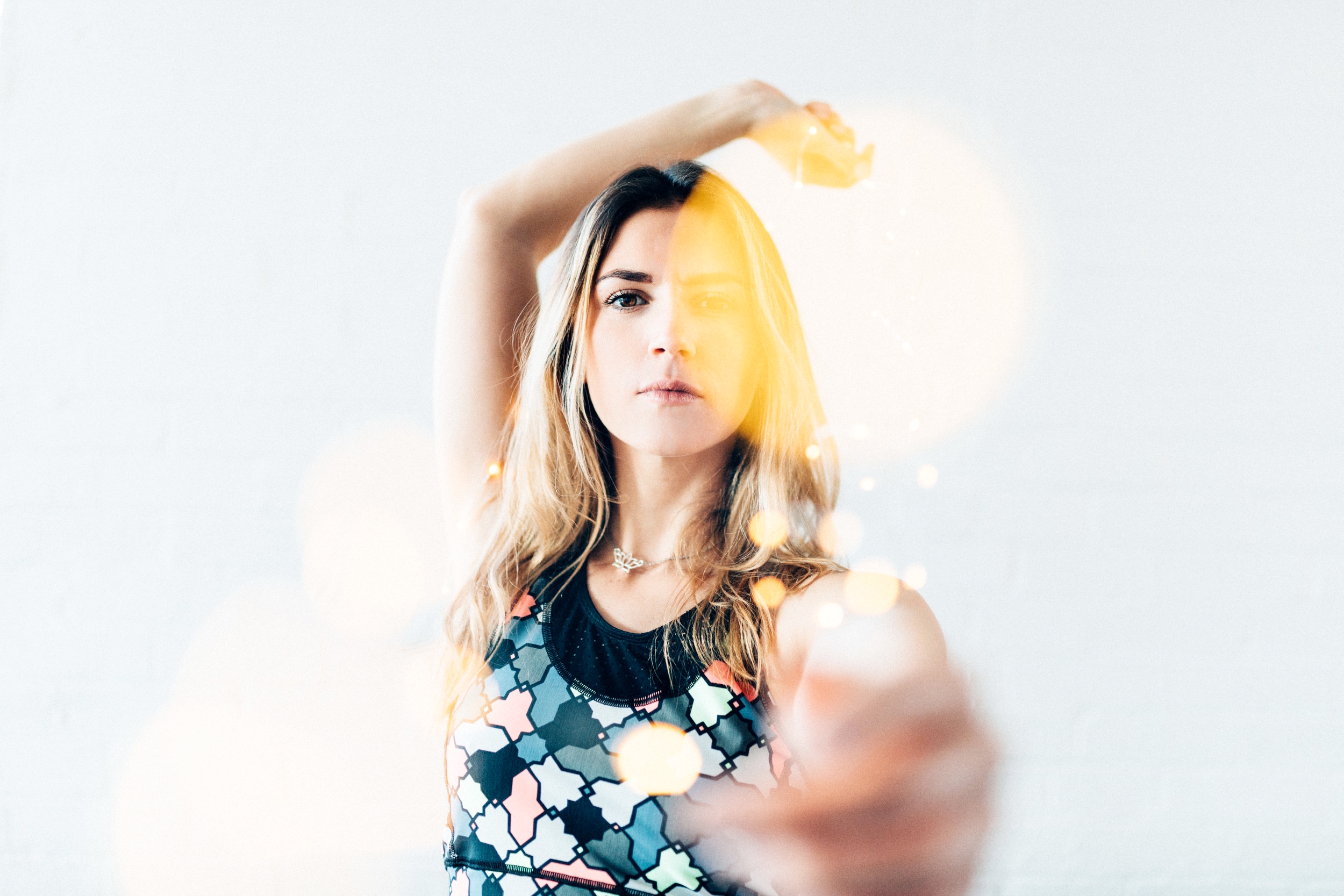
10 Stretches To Do At Your Desk
It’s likely that when you sit at a desk for a number of hours a week that once in a while you’ll have a few achy, uncomfortable joints or muscles. You may occasionally get an achy lower back, a tight neck or tight hamstrings from sitting at a desk.
It’s likely that when you sit at a desk for a number of hours a week that once in a while you’ll have a few achy, uncomfortable joints or muscles. You may occasionally get an achy lower back, a tight neck or tight hamstrings from sitting at a desk. Even if you feel these don’t effect you now I would still recommend trying and incorporating them for many reasons - the maintenance of your spine, preventing future injury, preventing the rounding of shoulders/poor posture. In addition, taking a few minutes out to breathe and get your body moving, even sitting at a desk, will help you feel energised and more alert during your working day,
The following ten stretches should help you to ease these. Not all of them need to be done together but they all bring a different benefit and open up a different part of the body. Perhaps you find three that work well for you and try to integrate them into your daily routine.
Start sitting in the middle of your seat so that you can sit up tall without touching its back and complete the following sequence - it should take around ten minutes in total with sufficient pausing and breathing in each.
1 & 2. Seated Cat Cow
Take your hands to your knees, lift your chest and pull your shoulders back - take a deep inhale and as you exhale, round your spine, drop your chin to your chest, bring your thoracic (middle) spine towards the back of the chair.
3. Neck Stretch
Take your hands under your thighs and sit up as tall as you can. Let the right ear drop toward your right shoulder, hold here for 30 seconds until you feel a gentle release and repeat on the other side.
4. Reach Up
Take your hands together above your head, interlace them and pop out your first finger pointing to the sky. Stretch arms up as high as you can to lengthen your spine and let your self stretch right and left, staying on one side for a few moments.
5. Seated Twist
Take one hand behind you to the top of the chair and the other to the arm rest or the side of the seat. Lift up as tall as you can, take a breath in and twist as you breathe out. Hold it for at least 30 seconds, keeping long through your spine. Release and repeat on the other side.
6. Hip Opener
Take your right ankle over the top of the left thigh and flex the foot. Gently draw the right knee towards the ground, hold the knee and ankle and hinge forward. Hopefully you feel it in your outer right hip. Repeat on the other side.
7. Eagle Arms, Upper Back Stretch
Reach your arms to each side and then wrap the right under the left, bend your elbows, squeeze the arms together and wrap the hands until they touch. Shrug the shoulders down and draw your forearms and hands forwards and up. Hold for 20 seconds and repeat on the left side.
8. Calf Stretch
Come to stand, bend through one knee and place the other heel on the ground, flexing that foot. Hold on to the desk or the back of your chair and slowly fold forward.
9. Quad Stretch
Stand tall and take the weight into one foot, lift the other and bend that knee, catching the foot in your hand. Keep the knees together and draw your hips forward, bringing the heel towards your bottom.
10. Back body and neck
Interlace hands behind your lower back, draw the shoulders behind you, extend arms, lift hands away from body and drop chin to sternum. You can do this sitting or standing at any point of the day and it should release tension in the shoulders and neck.
Vishuddha, The Throat Chakra
Vishuddha is the energy center of communication, expression, and rationality. It is the fifth of the chakras and acts as a link between the heart and the head, between emotions and rationality. It’s colour is blue and it’s element is ether. In balance, it enables you to communicate with ease, honesty and to show the truest version of yourself.
Vishuddha is the energy center of communication, expression, and rationality. It is the fifth of the chakras and acts as a link between the heart and the head, between emotions and rationality. It’s colour is blue and it’s element is ether. In balance, it enables you to communicate with ease, honesty and to show the truest version of yourself.
When your throat chakra is out of balance you may find it difficult to communicate and have an inability to express yourself, which consequently puts one’s identity at risk. If it is too strong it could manifest itself in dominance, supremacy or manipulation and if too weak it may manifest as shyness, awkwardness or fear of conflict.
On a physical level, health problems with the throat neck or teeth could be down to a blocked throat chakra. Moving the neck and opening the shoulders are effective to open up Visshudha. So below are four poses I find help to strengthen this Chakra.
1. Neck Release. The median nerve runs from the neck all the way down the arm to the fingers. This stretch is great to reduce the chances of getting tennis/golfers elbow and reduce tightness in the neck. Using this pose below, making space in the neck, applying gentle pressure on the side of the head and lengthening the arm should tap into the median nerve. To deepen this you can flex your extended hand, point the fingers to the sky and also you could pop the hand against a wall, whilst maintaining the same neck tilt.
Neck Release.
2. Bitilasana. This pose is often used in conjunction with cat pose, Marjaryasana - moving from one to the other using breath as a guide. Starting on all fours, hands under shoulders, knees under hips, drop the belly button to the earth, tilt the tailbone to the sky and open your heart forward. To invigorate the cervical, upper spine, let your neck join into the movement so long as it is comfortable.
Bitilasana. Cow Pose.
3. Salamba Sarvangasana. If you are ready for an inversion, this is a fantastic pose to strengthen the spine, core, legs and neck. It activates Vishuddha, reverses circulation and sends fresh blood to the throat. Please warm up a little through the neck, back and hamstrings before trying a shoulder stand, it is a test for your posterior chain (back body). And it is VERY important to keep your gaze forward to the sky, giving as little movement to the neck as possible. You are compressing your neck so be mindful. Lying down, rock your legs up and back behind your head, take your hands to the lower back and draw your elbows towards one another for stability. Lift the feet to the sky, point the toes, activate the legs and draw your hips towards the top of your mat (your head), whilst keeping toes high. If you feel good, staying here for 2-5 minutes, taking deep breaths.
Salamba Sarvangasana. Shoulder Stand.
4. Karnapidasana. This is a fairly advanced pose and will stretch your posterior chain. Coming from lying down, rock your feet up and behind you. Begin by extending the legs long if the hamstrings allow and then bending the knees, guide them down towards your ears. To modify, keep your hands on your lower back to offer support. Like a shoulder stand, it’s so important to maintain a forward gaze with as little movement through your neck as possible. This pose stimulates the thyroid gland and activates the fifth chakra.
Karnapidasana. Knee to Ear Pose.
Be careful when trying the last two, take your time and warm up sufficiently!
Kiri xx
Muladhara, The Root Chakra
I am starting the year of classes with a strong theme of the chakras; the first week will be the root chakra, Muladhara. This is a combination of two Sanskrit words - “root” (Mula) and “base” or “support” (Adhara) and it is the first of the seven chakras. Although the chakras are part of the subtle body and not the physical, the area in which Muladhara is situated is around the coccyx, the pelvic floor at the base of the spine.
I am starting the year of classes with a strong theme of the chakras; the first week will be the root chakra, Muladhara. This is a combination of two Sanskrit words - “root” (Mula) and “base” or “support” (Adhara) and it is the first of the seven chakras. Although the chakras are part of the subtle body and not the physical, the area in which Muladhara is situated is around the coccyx, the pelvic floor at the base of the spine.
Traditionally Muladhara represents your basic needs; survival, safety, family ties, trust and it is the foundation and development of ones personality. When Muladhara chakra is blocked and out of balance, you will bounce from thought to thought, feel needy, insecure with feelings of laziness. When it is flowing freely, your basic needs are met; you feel safe, grounded and have inner peace.
In order to balance your root chakra, there are certain asana (poses) that release unwanted energy and also cultivate fresh energy. They tend to be grounding poses, where you can build a strong foundation so if you’re feeling a little frenzied, these should help. Most asana yoga practices will involve grounding poses targeting the root chakra, but by theming your practice you can draw attention to this which can enhance your time on the mat and usually allow you to feel differently off the mat too. So here are 5 poses that allow you to tap into it…
1. A good starting block is Sukhasana, a seated pose with crossed legs and a long spine. This pose gives you the ability to ground down through you sitting bones and feel a connection to the earth. As you begin to deepen your breathing, soften your jaw, your forehead and allow your fingers to curl in towards the palms (and allow your puppy to cuddle up next to you).
Sukhasana, Easy Pose
2. Vhirabidrasana means ‘fierce warrior’ and is a grounding and strong pose. It allows you to dig deep into yourself for strength, determination and patience.
Virabhadrasana, Warrior 2
3. Malasana. This pose brings you close to the earth, opens your hips and strengthens your back. Take your hands together into prayer and nudge the insides of your knees with your elbows to open the hips a little more.
Malasana, Low Squat
4. Anjaneyasana gives your psoas and quad muscles a deep opening. These are the largest muscles in the body and are associated with your fight or flight response. Keep your hips active but draw your weight forward and down whilst maintaining breath.
Anjanyasana, Cresent Lunge
5. Balasana, childs pose. This pose gives you a feeling of surrender; no need to hold up your body, but allow it to be supported by the earth. Breathe into your back body and relax your heart towards the mat, softening through your hips.
Balasana, Childs Pose
Come and join me on the mat this week to tap into the first energy chakra, Muladhara. It will be a strong but grounding practice. Book here to attend my yoga class in Tunbridge Wells.
LHB x
A Beginners Guide to the Chakras
Have you ever stepped onto the mat feeling frenzied or worried and after the practice walked off feeling a little lighter? Biologically speaking, you will have mustered up some endorphins to improve your mood (since it feels pretty good to move your body) however, ancient yogis and many teachers would reason this to how yoga and breathwork can unblock channels and pent up energy, allowing it to flow freely.
Have you ever stepped onto the mat feeling frenzied or worried and after the practice walked off feeling a little lighter? Biologically speaking, you will have mustered up some endorphins to improve your mood (since it feels pretty good to move your body) however, ancient yogis and many teachers would reason this to how yoga and breathwork can unblock channels and pent up energy, allowing it to flow freely.
Chakra is a Sanskrit word that means ‘wheel’, and it refers to the areas in the subtle body where energy flows. The main seven chakras are: root, sacral, solar plexus, heart, throat, third eye and crown. For ease, imagine that they travel from your coccyx (the root) up the spine to the top of your head (the crown). They are a complex network of energetic channels, each relating to a different element (earth, water, air) and each associated with their own colour.
The reality is that most classes flow through the chakras (if planned well). When we practice, we move in such a way to collect prana (energy, life-force) to enliven the chakras and to stabilise the mind so that they can come forward or open up. I know at first it can all seem a little far fetched but I now understand them as second nature which can really aid my self practice. So lets go through them…
Root Chakra - Muladhara
Located at your perineum or coccyx, it represents being grounded, safe and having survival needs met. Associated with the colour red and the element is relates to is earth. If it is out of balance and your basic needs are not met, you tend to have self destructive behaviours with low self esteem. But if it is balanced, you will feel confident, secure and safe.Sacral Chakra - Svadisthana
Located at your sacrum, it represents pleasure, fluidity, creativity, fertility and sexuality. Associated with the colour orange and the element it relates to is water. Out of balance you might be hard on yourself and feel guilty, but in balance you should feel deserving of living an abundant pleasurable life.
Solar Plexus Chakra - Manipura
Located by the belly button, it represents will power, that ‘gut feeling’, strength and assertion. Associated with the colour yellow and the element it relates to is fire. In balance you have self esteem and confidence and unbalanced you lack courage and become inert.
Heart Chakra - Anahata
Located at your heart, it of course represents love, unconditional love, compassion and intuition. Associated with the colour green and the element it relates to is air. When it is balanced you will be able to forgive, to love unconditionally and when it is closed you may have dysfunctional relationships and you may become possessive or codependent.
Throat Chakra - Vishuddha
Located at your throat, it represents communication, truth and reliability. Associated with the colour blue and the element it relates to is ether. In balance, you will be able to communicate with patience, no judgement and truth. If blocked, you may think your voice is the only truth and you may struggle to communicate and listen to others.
Third Eye Chakra - Ajna
Located in between your eyebrows or in your brain, it represents wisdom, imagination, intuition and the ability to analyse truth in the world. Associated with the colour indigo and the element it relates to is light. In balance you can trust your inner wisdom with life’s challenges, but unbalanced you are cynical and close minded.
Crown Chakra - Sahasrara
The final chakra doesn’t really have a place on the human body, but it is located just above your head. It represents a higher consciousness than yourself, helping you understand that you are far beyond the physical self. Associated with the colour indigo or white and the element it relates to is cosmic energy. When the chakra is closed, you believe that happiness comes from the outside but balanced you feel free and are able to find happiness within.
I hope that didn’t confuse you too much but gave you a general understanding of the chakras so you might be able to think if perhaps they need rebalancing or some time given to certain areas of body.
Please come to yoga with me in Tunbridge Wells to get a deeper understanding of them within your asana practice. Here is my timetable and for the next seven weeks we will be moving through a chakra based practice, focusing on one each week, beginning with Muladhara, the root chakra.
Peace.
Yoga and Mindfulness for Kids
My memories of school, ages 5-18, are almost entirely wonderful. I made friends for life, messed around with them, became netball captain, tormented teachers, became teachers pet, wore too much eyeliner, realised I loved geography, realised I hated PE, chased boys like nothing else and rolled my skirt up one too many times like any other grammar school girl.
My memories of school, ages 5-18, are almost entirely wonderful. I made friends for life, messed around with them, became netball captain, tormented teachers, became teachers pet, wore too much eyeliner, realised I loved geography, realised I hated PE, chased boys like nothing else and rolled my skirt up one too many times like any other grammar school girl. Did I get stressed about work and exams? I suppose. Did I feel pressure from school or parents? Kinda. For me, the work was never the issue. Looking back, I now see that I may have had a few minor mental health issues... No big deal, I was just a young girl; I felt inadequate and always in competition with fellow students and I always thought their opinions defined me. It was nothing serious at all, but I remember feeling like that. In addition, I was just a typical teenager; making my parents lives difficult, sulking when I didn't get my own way, storing Bacardi Breezers under my bed aged 15 and refusing to do homework. Since then, I've grown up a little bit and now store the alcohol in the fridge.
Practising yoga, using mindfulness apps and listening to guided meditation podcasts has changed my mindset entirely over the last few years. Although I'm grateful I found these at 23, I'm also gutted I only found them at 23.
There is a huge amount of evidence that illustrates the benefits of yoga; benefitting the mind as well as the body. Yoga's physical benefits... it promotes lean muscle and muscle growth, improves flexibility, regulates adrenals, improves digestion, helps you focus and aids sleep - plus about a million other things. Even baby yoga has physical, physiological and psychological benefits; promoting better sleep and digestion. Yoga can be gentle, which is perhaps why it has a reputation for being popular with older generations. But more and more it is being practised in younger children, teens and yes, even babies. Looking after your body with stretches, strengthening, breathing and mindfulness will undoubtedly encourage a routine and kickstart those physical and mental benefits from a young age.
Kids today are more likely to battle with negative emotions, anxiety and stress (Garner, 2018). And as pressure increases not only in school, but from parents and social media, the number of those self harming has increased by 68%, mental health issues by 46% and with cyber bullying also on the rise - things aren't looking great (Tait, 2018). No one is claiming that yoga, mindfulness and meditation are the solution, but it has been shown as one way to reduce levels of stress and anxiety in school children. I've also seen first-hand benefits in students who use my yoga class as a time to de-stress, switch off from the outside world and leave in a calmer headspace.
As I've already said, my time at school was really enjoyable but that doesn't mean to say I wouldn't have benefitted from yoga and a little mindfulness. I found PE stressful and tended to be 'on my period' every week to get out of it. A study of High School students found that practicing yoga reduced levels of stress, bad mood, negative emotions and other mental health problems and in fact the levels among those students doing PE actually increased/worsened (Hagins and Rundle, 2016). Yoga encourages self acceptance, teaches different breathing techniques to control emotions and brings you into the present moment; reducing worry about the past and stress about the future. I wish I had started sooner, but I'm also delighted that I didn't go another 20 years before I discovered yoga. A practice that encourages self acceptance and reminds you that you're perfect as you are can't be a bad one... and if you're a cynic, at least you'll have a good laugh ;)
LHB
P.S. Youtube is your best friend. If yoga or meditation intimidates you or weirds you out... but you're intrigued... get online and watch cat meffan or yoga with adrienne.
Introduction to yoga
I won't assume that readers of little health bunny are keen yogis/yoginis, so let us start with the basics of what yoga is, what it's not, why people do it and also explain a few things I wish I knew when I first started practising.
I won't assume that readers of little health bunny are keen yogis/yoginis, so let us start with the basics of what yoga is, what it's not, why people do it and also explain a few things I wish I knew when I first started practising.
The word yoga by definition means 'union', of body mind and spirit. Yoga intends to increase connection; perhaps this means connecting to ourselves, to connect our body with our mind, perhaps it means connecting to the world, surroundings, to others. Personally, time on the mat gives me time to check in with how I'm feeling physically, emotionally and sets me up for the day. In our busy lives we get swept from work to the gym to social occasions to bed, always looking forward to what's next or dwelling on what happened last week - it is so rare that we stop and take time to get/feel grounded. For an hour, an hour and a half, yoga and meditation give you the opportunity to let yourself off the hook; to shrug off your thoughts, frustrations, stories, worries, expectations and focus on the present moment. As a teacher, I hope to lift weight off students shoulders; to give them a space free of judgement, to get in touch with their breathing and themselves.
The word or sound OM. It is a mantra and is said to be the sound of the universe (like the noise and vibration you hear/feel when you put your ear to a seashell). You know how 'good vibes' is a popular saying? No matter what pitch or length it is, the vibrations you make with an OM gives out energy and lets energy flow through you. If that's all a little too hard to grasp - essentially it is just a hum. I find in a group environment it is a way to connect/unite us all and it is incredibly relaxing once you overcome the unfamiliarity/peculiarity/embarrassment.
Sanskrit. What are these odd words the teacher keeps repeating? I may be stating the obvious here, but yoga isn't a new fad, it has been practised for thousands of years. Sanskrit is the language of yoga that has been passed down generation to generation. Personally I was taught using sanskrit and feel it's only right to continue using this throughout my own teaching... plus, the vocabulary can be long, complicated, obscure and I've worked so hard to remember it so I think it's only right to share!
The term namaste. Generally it opens and closes the class and means 'I bow to the divine in you' - I have also heard 'the light in me bows to the light in you'; it's a way of showing respect and perhaps thanks.
Yoga is an umbrella term which encompasses thousands of traditions, philosophies and teachings. I practised and therefore learnt to teach hatha and vinyasa flow yoga. There are many other branches, including kundalini, ashtanga, iyengar, yin (the list goes on and I would only be able to name a handful anyway) and then within one type of yoga... many more branches. In addition, different teachers will teach in different styles; not one class can be the same as another - some more spiritual, some based on alignment, some focused on meditation or mantras... some are just very challenging sweaty workouts. So when someone claims that yoga 'isn't for them'... I tend to think they just haven't found the right teacher.
Unlike other forms of fitness, yoga encompasses so much more. Instead of working towards a goal, yoga is an ongoing practise. Yes, over time you will likely become physically stronger and more flexible... but hopefully so will your mind.
There is a whole world of yoga I will try to share with you, bit by bit, week by week. But for now, I will leave it at that and say namaste - have a happy hump day.
LHB

